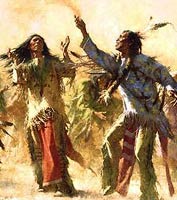
As with many a metaphysical topic, there often is much debate and contrary thought within the same principle. Extensive reading about any Indian culture’s religion or philosophy will no doubt bring forward differing views, to the extent that one elder or holy man may directly contradict another on any given topic.
This has become particularly true in the last few decades with the wave of cross-cultural interest in American Indians – a time when suddenly everyone and his uncle, Indian and non-Indian, is a “shaman” and writing books, teaching seminars and hosting sweat lodge on board cruise ships.
While individual spin is commonplace on the cusp of a new millennium, there are some general basic concepts that remain fairly universal, concepts that appear the purest among the elders teaching at the turn of the last century. Fortunately, some were very prolific. Lakotas like George Sword and George Bushotter wrote extensively in the Lakota language of their personal experience and others, like Thomas Tyon and Ivan Stars, interviewed nonliterate Lakotas to record their stories.
This, combined with Lakota narratives taken down by non-Indians such as James R. Walker, Edward Curtis, Frances Densmore, Aaron McGaffey Beede, Joseph Epes Brown and John G. Neihardt, who interviewed Oglala holy man Nicholas Black Elk extensively, give us a fair picture of things as they are without having been tampered with by egos or ulterior motives.
Our links labeled “Lakota” are intended as a brief introduction to some traditional concepts of Lakota belief and religion and are based largely in the sources named above and focus on the 19th and early 20th century teachings, rather than any contemporary writings. In these times religion was an integral part of day-to-day life.





